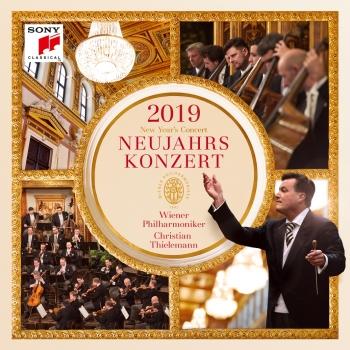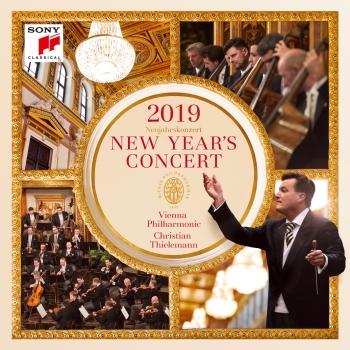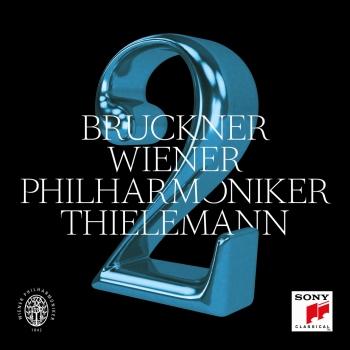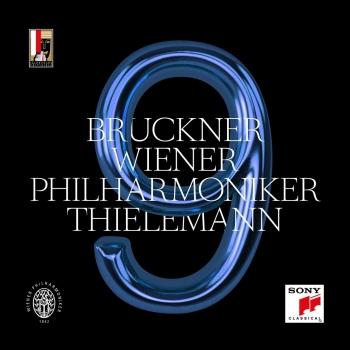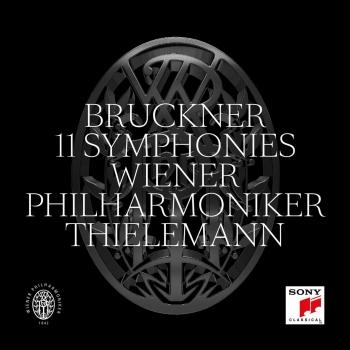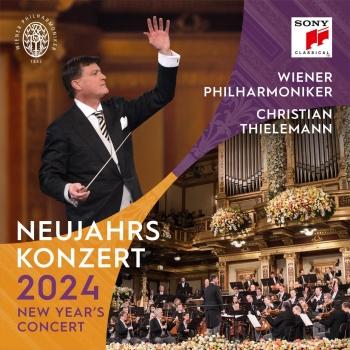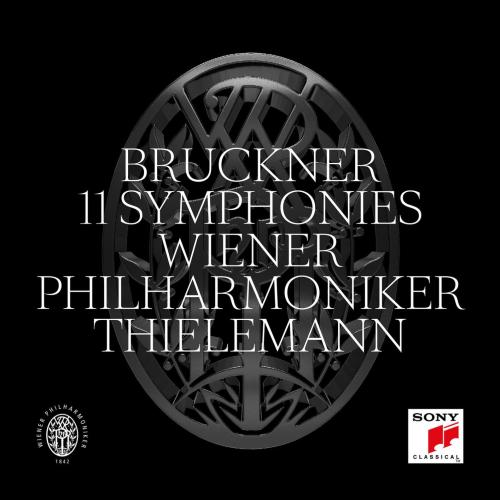
Bruckner: Complete Symphonies Edition (11 Symphonies) Christian Thielemann & Wiener Philharmoniker
Album info
Album-Release:
2020
HRA-Release:
13.10.2023
Label: Sony Classical
Genre: Classical
Subgenre: Orchestral
Artist: Christian Thielemann & Wiener Philharmoniker
Composer: Anton Bruckner (1824-1896)
Album including Album cover
I`m sorry!
Dear HIGHRESAUDIO Visitor,
due to territorial constraints and also different releases dates in each country you currently can`t purchase this album. We are updating our release dates twice a week. So, please feel free to check from time-to-time, if the album is available for your country.
We suggest, that you bookmark the album and use our Short List function.
Thank you for your understanding and patience.
Yours sincerely, HIGHRESAUDIO
- Anton Bruckner (1824 - 1896): Symphony in F Minor, WAB 99 (Nowak Edition, "Nullified" First Symphony, also called "Study Symphony"):
- 1 Bruckner: Symphony in F Minor, WAB 99: I. Allegro molto vivace 14:49
- 2 Bruckner: Symphony in F Minor, WAB 99: II. Andante molto 11:36
- 3 Bruckner: Symphony in F Minor, WAB 99: III. Scherzo. Schnell - Trio. Langsamer 05:16
- 4 Bruckner: Symphony in F Minor, WAB 99: IV. Finale. Allegro 07:07
- Symphony No. 1 in C Minor, WAB 101 (Nowak Edition):
- 5 Bruckner: Symphony No. 1 in C Minor, WAB 101 (Nowak Edition): I. Allegro - Langsam - Tempo I 13:46
- 6 Bruckner: Symphony No. 1 in C Minor, WAB 101 (Nowak Edition): II. Adagio - Andante - Tempo I 13:03
- 7 Bruckner: Symphony No. 1 in C Minor, WAB 101 (Nowak Edition): III. Scherzo. Lebhaft - Trio. Langsam 09:27
- 8 Bruckner: Symphony No. 1 in C Minor, WAB 101 (Nowak Edition): IV. Finale. Bewegt, feurig 16:48
- Symphony in D Minor, WAB 100 ("Nullified" Second Symphony, also called "nullte"):
- 9 Bruckner: Symphony in D Minor, WAB 100 ("Nullified" Second Symphony, also called "nullte"): I. Allegro 16:21
- 10 Bruckner: Symphony in D Minor, WAB 100 ("Nullified" Second Symphony, also called "nullte"): II. Andante 13:29
- 11 Bruckner: Symphony in D Minor, WAB 100 ("Nullified" Second Symphony, also called "nullte"): III. Scherzo. Presto - Trio. Langsamer und ruhiger 07:01
- 12 Bruckner: Symphony in D Minor, WAB 100 ("Nullified" Second Symphony, also called "nullte"): IV. Finale. Moderato - Allegro vivace 10:01
- Symphony No. 2 in C Minor, WAB 102 (Carragan Edition):
- 13 Bruckner: Symphony No. 2 in C Minor, WAB 102 (Carragan Edition): I. Moderato 18:02
- 14 Bruckner: Symphony No. 2 in C Minor, WAB 102 (Carragan Edition): II. Andante. Feierlich, etwas bewegt 18:04
- 15 Bruckner: Symphony No. 2 in C Minor, WAB 102 (Carragan Edition): III. Scherzo. Mäßig schnell - Trio. Gleiches Tempo 06:42
- 16 Bruckner: Symphony No. 2 in C Minor, WAB 102 (Carragan Edition): IV. Finale. Mehr schnell 15:18
- Symphony No. 3 in D Minor, WAB 103 (Nowak Edition):
- 17 Bruckner: Symphony No. 3 in D Minor, WAB 103 (Nowak Edition): I. Gemäßigt, mehr bewegt, misterioso 20:24
- 18 Bruckner: Symphony No. 3 in D Minor, WAB 103 (Nowak Edition): II. Andante. Bewegt, feierlich, quasi Adagio 16:20
- 19 Bruckner: Symphony No. 3 in D Minor, WAB 103 (Nowak Edition): III. Scherzo. Ziemlich schnell - Trio 07:32
- 20 Bruckner: Symphony No. 3 in D Minor, WAB 103 (Nowak Edition): IV. Finale. Allegro 16:57
- Symphony No. 4 in E-Flat Major, WAB 104 (Haas Edition):
- 21 Bruckner: Symphony No. 4 in E-Flat Major, WAB 104 (Haas Edition): I. Bewegt, nicht zu schnell 19:23
- 22 Bruckner: Symphony No. 4 in E-Flat Major, WAB 104 (Haas Edition): II. Andante quasi Allegretto 16:12
- 23 Bruckner: Symphony No. 4 in E-Flat Major, WAB 104 (Haas Edition): III. Scherzo. Bewegt. Trio. Nicht zu schnell. Keinesfalls schleppend 11:12
- 24 Bruckner: Symphony No. 4 in E-Flat Major, WAB 104 (Haas Edition): IV. Finale. Bewegt, doch nicht zu schnell 22:55
- Symphony No. 5 in B-Flat Major, WAB 105 (Nowak Edition):
- 25 Bruckner: Symphony No. 5 in B-Flat Major, WAB 105 (Nowak Edition): I. Introduction. Adagio - Allegro 22:47
- 26 Bruckner: Symphony No. 5 in B-Flat Major, WAB 105 (Nowak Edition): II. Adagio. Sehr langsam 19:00
- 27 Bruckner: Symphony No. 5 in B-Flat Major, WAB 105 (Nowak Edition): III. Scherzo. Molto vivace - Trio 14:51
- 28 Bruckner: Symphony No. 5 in B-Flat Major, WAB 105 (Nowak Edition): IV. Finale. Adagio - Allegro moderato 25:20
- Symphony No. 6 in A Major, WAB 106 (Nowak Edition):
- 29 Bruckner: Symphony No. 6 in A Major, WAB 106 (Nowak Edition): I. Majestoso 15:37
- 30 Bruckner: Symphony No. 6 in A Major, WAB 106 (Nowak Edition): II. Adagio. Sehr feierlich 16:20
- 31 Bruckner: Symphony No. 6 in A Major, WAB 106 (Nowak Edition): III. Scherzo. Nicht schnell - Trio. Langsam 08:13
- 32 Bruckner: Symphony No. 6 in A Major, WAB 106 (Nowak Edition): IV. Finale. Bewegt, doch nicht zu schnell 13:54
- Symphony No. 7 in E Major, WAB 107 (Haas Edition):
- 33 Bruckner: Symphony No. 7 in E Major, WAB 107 (Haas Edition): I. Allegro moderato 22:06
- 34 Bruckner: Symphony No. 7 in E Major, WAB 107 (Haas Edition): II. Adagio. Sehr feierlich und sehr langsam - Moderato - Tempo I 22:43
- 35 Bruckner: Symphony No. 7 in E Major, WAB 107 (Haas Edition): III. Scherzo. Sehr schnell - Trio. Etwas langsamer 09:56
- 36 Bruckner: Symphony No. 7 in E Major, WAB 107 (Haas Edition): IV. Finale. Bewegt, doch nicht schnell 13:59
- Symphony No. 8 in C Minor, WAB 108 (Haas Edition):
- 37 Bruckner: Symphony No. 8 in C Minor, WAB 108 (Haas Edition): I. Allegro moderato 15:42
- 38 Bruckner: Symphony No. 8 in C Minor, WAB 108 (Haas Edition): II. Scherzo. Allegro moderato - Trio. Langsam 15:35
- 39 Bruckner: Symphony No. 8 in C Minor, WAB 108 (Haas Edition): III. Adagio. Feierlich langsam; doch nicht schleppend 26:26
- 40 Bruckner: Symphony No. 8 in C Minor, WAB 108 (Haas Edition): IV. Finale. Feierlich, nicht schnell 23:45
- Symphony No. 9 in D Minor, WAB 109 (Nowak Edition):
- 41 Bruckner: Symphony No. 9 in D Minor, WAB 109 (Nowak Edition): I. Feierlich, Misterioso 23:23
- 42 Bruckner: Symphony No. 9 in D Minor, WAB 109 (Nowak Edition): II. Scherzo. Bewegt, lebhaft - Trio. Schnell 10:29
- 43 Bruckner: Symphony No. 9 in D Minor, WAB 109 (Nowak Edition): III. Adagio. Langsam, feierlich 23:46
Info for Bruckner: Complete Symphonies Edition (11 Symphonies)
Anton Bruckner: 11 Symphonies" is the first complete recording of the symphonies of the Vienna Philharmonic under a single conductor - Christian Thielemann - who enjoys a close relationship with the world-class orchestra and has established himself as one of the most respected interpreters of the romantic Austro-German repertoire of his generation.
The edition contains 11 symphonies, in addition to the well-known symphonies Nos. 1 to 9, the so-called "Zeroth", as well as the "Study Symphony", and a 172-page booklet. The release of the complete recording comes in the run-up to the composer's 200th birthday in 2024. Few orchestras can boast such a special closeness to Bruckner as the Vienna Philharmonic, which this year won the OPUS-Klassik "Orchestra of the Year" award for its pre-released recording of Anton Bruckner's Ninth Symphony.
Bruckner's cycle of nine numbered and two unnumbered symphonies is one of the great spiritual autobiographies of musical literature. The symphonic journey began in 1863 with his so-called "Study Symphony", a work that demonstrated the composer's fluency in the musical language of his time. Three years later, Bruckner wrote Symphony No. 1, whose bold conclusion heralded the beginning of a great symphonic career. Demanding and self-critical, Bruckner suppressed his next symphony of 1869, which became known as the "Zeroth Symphony" and was often excluded from complete recordings. That hasn't stopped musicians like Christian Thielemann from recognising its exciting qualities, including a rousing scherzo and a riveting finale.
Bruckner's buoyant Symphony No. 2, which followed, is one of his freshest and lightest-footed works. In 1873 he wrote a symphony modelled on Beethoven's iconic Ninth, but inspired by the melodicism of Richard Wagner. Symphony No. 3 is a bold and sonorous symphony written during the composer's most prolific creative period. It was followed by the composer's most popular symphony ever: Bruckner's "romantic" Symphony No. 4 can seem like a musical monolith chiselled from a single block. Few symphonies convey Bruckner's unmistakable combination of mystery and warmth like this extraordinary, luminous work. A deeply disturbed Bruckner completed the 5th Symphony in 1876, and the work's tragic disposition leads to an overwhelming resolution in the last movement. The 6th Symphony, completed in 1881, is one of Bruckner's most fascinating and unusual creations - a work in which the composer's gothic structures take on a translucent elegance, serene, delicate, sublime and noble. None of his works gave Bruckner as much joy and pride as his 7th Symphony. It is his most tender orchestral creation and his most immediately beautiful - a work that contains a heartfelt eulogy to Wagner, but also brims with excitement and flexibility. It was completed in 1883.
Vier Jahre später beendete Bruckner die erste Fassung seiner 8. Sinfonie, einer manchmal düsteren spirituellen Suche, die in glühender Positivität endet, deren unbeantwortete Fragen aber noch lange nach dem Erklingen der letzten Note nachwirken. Es ist ein Werk von zauberhafter Feierlichkeit und fesselnder Zeitlosigkeit, und es ist auch die erste Bruckner-Sinfonie, die den unverwechselbaren Klang der Harfe in sich trägt. Das Schicksal wollte es, dass Bruckners 9. Sinfonie seine letzte sein sollte. Tatsächlich lag sie unvollendet auf dem Schreibtisch des Komponisten, als er im Oktober 1896 starb. Selbst in den drei Sätzen, die der Komponist fertigstellte, erleben wir intensive Kraft, kataklystischen Schrecken und erlesene Zärtlichkeit. Ein großes, verklärendes Adagio bildet Bruckners Epitaph.
"...that recordings have been made here which no one in the 21st century will be able to surpass so quickly. ... How profoundly orchestra and conductor explore Bruckner's cosmos here... Addictive potential!" (WAZ)
"Masterful, kapellmeisterlich, dreamlike." (Der Standard)
"Beautiful to the point of tears and artistically perfect. The interpretation of the Fifth may be called a milestone. The way the musicians realised this work was simply grandiose." (Kurier)
"Only the highest musical perfection sounds like this." (Die Presse)
Vienna Philharmonic Orchestra
Christian Thielemann, conductor
Christian Thielemann
was born in Berlin in 1959 and began what Karajan called the classical conductor’s “hard but indispensable slog” through numerous small theatres at an early age. After 20 years of operatic experience, Thielemann, who also has been guest conductor-in-chief at the Teatro Comunale of Bologna, started concentrating on a few selected orchestras and opera houses such as Covent Garden in London, the Metropolitan in New York and the Vienna State Opera. From 1997–2004 he was music director of the Deutsche Oper, Berlin, and in 2004 he was appointed music director of the Münchner Philharmoniker. Thielemann received Germany’s Bundesverdienstkreuz in 2003.
Dresden Staatskapelle
On 22nd September 2008 the Staatskapelle Dresden celebrated its 460th jubilee. Founded by Prince Elector Moritz von Sachsen in 1548, it is one of the oldest orchestras in the world and steeped in tradition. Over its long history, many distinguished conductors and internationally celebrated instrumentalists have left their mark on this one-time court
Previous directors include Heinrich Schütz, Johann Adolf Hasse, Carl Maria von Weber and Richard Wagner, who called the ensemble his »miraculous harp«. The list of prominent conductors of the last 100 years includes Ernst von Schuch, Fritz Reiner, Fritz Busch, Karl Böhm, Joseph Keilberth, Rudolf Kempe, Otmar Suitner, Kurt Sanderling, Herbert Blomstedt and Giuseppe Sinopoli. The orchestra was directed by Bernard Haitink from 2002-2004 and most recently by Fabio Luisi from 2007-2010. Principal Conductor since the 2012 / 2013 season has been Christian Thielemann. In May 2016 the former Principal Conductor Herbert Blomstedt received the title Conductor Laureate. This title has only been awarded to Sir Colin Davis before, who held it from 1990 until his death in April 2013. Myung-Whun Chung has been Principal Guest Conductor since the 2012 / 2013 season.
Richard Strauss and the Staatskapelle were closely linked for more than sixty years. Nine of the composer’s operas were premiered in Dresden, including »Salome«, »Elektra« and »Der Rosenkavalier«, while Strauss’s »Alpine Symphony« was dedicated to the orchestra. Countless other famous composers have written works either dedicated to the orchestra or first performed in Dresden. In 2007 the Staatskapelle reaffirmed this tradition by introducing the annual position of »Capell- Compositeur«. Following on from Hans Werner Henze and Wolfgang Rihm, Sofia Gubaidulina will hold the title for the 2014/2015 season.
The Staatskapelle’s home is the Semperoper, where it performs around 260 operas and ballets each season. In addition the ensemble presents another 50 symphonic and chamber concerts in the opera house, as well as playing at various musical events in Dresden’s Frauenkirche. As one of the world’s most celebrated and popular symphony orchestras, the Staatskapelle regularly travels abroad to the world’s leading classical venues.
From 2013 the Staatskapelle Dresden is the resident orchestra of the Salzburg Easter Festival, whose Artistic Director is none other than Christian Thielemann. The Staatskapelle also does valuable work to support the local region: Since October 2008 it has been the patron orchestra of Meetingpoint Music Messiaen in the double city of Görlitz- Zgorzelec. And in September 2010 the orchestra helped found the International Shostakovich Festival in Gohrisch (Saxon Switzerland), which is the only such annual event dedicated to the music and life of Dmitri Shostakovich.
At a ceremony in Brussels in 2007 the Staatskapelle became the first – and so far only – orchestra to be awarded the »European Prize for the Preservation of the World’s Musical Heritage«.
Volkswagen´s Transparent Factory has been a Partner of the Staatskapelle Dresden since 2008.
This album contains no booklet.












